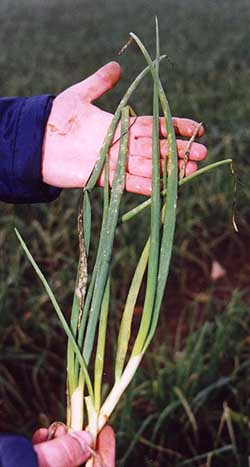
The first signs of Downy Mildew infection have recently been identified in spring set onion crops, and disease is predicted to quickly move into spring drilled crops, now at the four to five true leaf stage.
Andy Richardson of the Allium & Brassica Centre reports high disease pressure in overwintered crops. Whilst relatively cold, dry conditions in April and May held significant early-season mildew attacks at bay, current warm, showery weather has increased spore production and disease pressure, he warns.
With the increasing problems of Downy Mildew over recent years, Mr Richardson now advocates growers use a fungicide mixture for each spray throughout the season, aiming to provide both eradicant and preventative properties with each application.
"Previously growers would typically start the programme with two or three applications of preventative Bravo (chlorothalonil), before switching to an eradicant mid-season. We now know mixing Bravo with Invader (dimethomorph + mancozeb), and alternating that with a powerful Folio Gold + Amistar mix, gives the best chance of keeping disease out of the crop," he advises. Crops will typically receive three applications of each mix in a six-spray programme.
If any Downy Mildew lesions are identified at an early stage, he recommends the two eradicants - Folio Gold (chlorothalonil + mefenoxam) plus Invader - can be mixed as a double hit, with the aim of drying up lesions before they become established.
Mr Richardson highlights the warm showery weather conditions since late May that have brought Downy Mildew back with a vengeance in the over-wintered crop. Although it will have little effect now - the crop is currently being harvested and destined for processing - infection of spring crops could have serious consequences for skin quality and yield, as well as providing an entry point for damaging bacterial and neck rot infections. The mixed programme with Bravo and Amistar should prevent Botrytis leaf spot and reduce Cladosporium leaf blotch infection, he adds.
Spray interval timing will be dictated this season by disease pressure warnings from Warwick HRI, linked to in-field weather monitoring. Mr Richardson believes spray intervals may be extended to a maximum of 14 days in settled, dry conditions, but will be reduced down to seven days when infection risk is high.
With the UK onion crop area down by around 17% this year, he calculates home production is likely to match demand at around 400,000t, assuming average rainfall. With similar acreage cuts across Europe, after massive overproduction and poor prices in 2004/5 there is potential for better prices and returns for UK growers this season.
